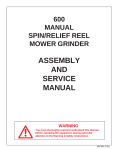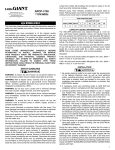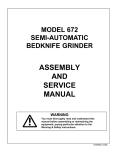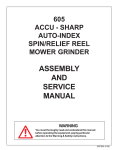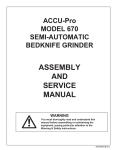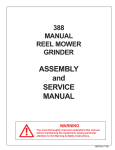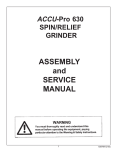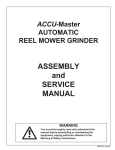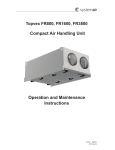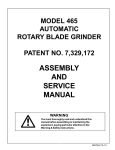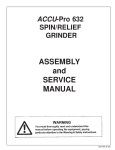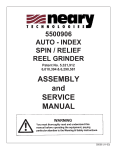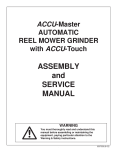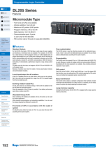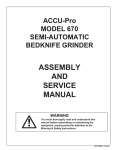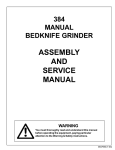Download ASSEMBLY AND SERVICE MANUAL
Transcript
600 MANUAL SPIN/RELIEF REEL MOWER GRINDER ASSEMBLY AND SERVICE MANUAL WARNING You must thoroughly read and understand this manual before operating the equipment, paying particular attention to the Warning & Safety instructions. 1 6007954 (9-99) SAFETY INSTRUCTIONS Safety Awareness Symbols are inserted into this manual to alert you to possible Safety Hazards. Whenever you see these symbols, follow their instructions. The Warning Symbol identifies special instructions or procedures which, if not correctly followed, could result in personal injury. The Caution Symbol identifies special instructions or procedures which, if not strictly observed, could result in damage to or destruction of equipment. 1. KEEP GUARDS IN PLACE and in working order. 13. MAINTAIN GRINDER WITH CARE. Follow instructions in Service Manual for lubrication and preventive maintenance. 2. REMOVE WRENCHES AND OTHER TOOLS. 3. KEEP WORK AREA CLEAN. 4. DON'T USE IN DANGEROUS ENVIRONMENT. Don't use Grinder in damp or wet locations, or expose it to rain. Keep work area well lighted. 5. KEEP ALL VISITORS AWAY. All visitors should be kept a safe distance from work area. 14. DISCONNECT POWER BEFORE SERVICING, or when changing the grinding wheel. 15. REDUCE THE RISK OF UNINTENTIONAL STARTING. Make sure the switch is OFF before plugging in the Grinder. 6. MAKE WORK AREA CHILD-PROOF with padlocks or master switches. 16. USE RECOMMENDED ACCESSORIES. Consult the manual for recommended accessories. Using improper accessories may cause risk of personal injury. 7. DON'T FORCE THE GRINDER. It will do the job better and safer if used as specified in this manual. 17. CHECK DAMAGED PARTS. A guard or other part that is damaged or will not perform its intended function should be properly repaired or replaced. 8. USE THE RIGHT TOOL. Don't force the Grinder or an attachment to do a job for which it was not designed. 18. NEVER LEAVE GRINDER RUNNING UNATTENDED. TURN POWER OFF. Do not leave grinder until it comes to a complete stop. 9. WEAR PROPER APPAREL. Wear no loose clothing, gloves, neckties, or jewelry which may get caught in moving parts. Nonslip footwear is recommended. Wear protective hair covering to contain long hair. 19. KNOW YOUR EQUIPMENT. Read this manual carefully. Learn its application and limitations as well as specific potential hazards. 10. ALWAYS USE SAFETY GLASSES. 11. SECURE YOUR WORK. Make certain that the cutting unit is securely fastened with the clamps provided before operating. 12. DON'T OVERREACH. Keep proper footing and balance at all times. 20. KEEP ALL SAFETY DECALS CLEAN AND LEGIBLE. If safety decals become damaged or illegible for any reason, replace immediately. Refer to replacement parts illustrations in Service Manual for the proper location and part numbers of safety decals. 21. DO NOT OPERATE THE GRINDER WHEN UNDER THE INFLUENCE OF DRUGS, ALCOHOL, OR MEDICATION. 2 SAFETY INSTRUCTIONS IMPROPER USE OF GRINDING WHEEL MAY CAUSE BREAKAGE AND SERIOUS INJURY. Grinding is a safe operation if the few basic rules listed below are followed. These rules are based on material contained in the ANSI B7.1 Safety Code for "Use, Care and Protection of Abrasive Wheels". For your safety, we suggest you benefit from the experience of others and carefully follow these rules. DO DON'T 1. DO always HANDLE AND STORE wheels in a CAREFUL manner. 1. DON'T use a cracked wheel or one that HAS BEEN DROPPED or has become damaged. 2. DO VISUALLY INSPECT all wheels before mounting for possible damage. 2. DON'T FORCE a wheel onto the machine OR ALTER the size of the mounting hole - if wheel won't fit the machine, get one that will. 3. DO CHECK MACHINE SPEED against the established maximum safe operating speed marked on wheel. 3. DON'T ever EXCEED MAXIMUM OPERATING SPEED established for the wheel. 4. DO CHECK MOUNTING FLANGES for equal and correct diameter. 4. DON'T use mounting flanges on which the bearing surfaces ARE NOT CLEAN, FLAT AND FREE OF BURNS. 5. DO USE MOUNTING BLOTTERS when supplied with wheels. 6. DO be sure WORK REST is properly adjusted. 5. DON'T TIGHTEN the mounting nut excessively. 7. DO always USE A SAFETY GUARD COVERING at least one-half of the grinding wheel. 6. DON'T grind on the SIDE OF THE WHEEL (see Safety Code B7.2 for exception). 8. DO allow NEWLY MOUNTED WHEELS to run at operating speed, with guard in place, for at least one minute before grinding. 7. DON'T start the machine until the WHEEL GUARD IS IN PLACE. 8. DON'T JAM work into the wheel. 9. DO always WEAR SAFETY GLASSES or some type of eye protection when grinding. 9. DON'T STAND DIRECTLY IN FRONT of a grinding wheel whenever a grinder is started. 10. DON'T FORCE GRINDING so that motor slows noticeably or work gets hot. AVOID INHALATION OF DUST generated by grinding and cutting operations. Exposure to dust may cause respiratory ailments. Use approved NIOSH or MSHA respirators, safety glasses or face shields, and protective clothing. Provide adequate ventilation to eliminate dust, or to maintain dust level below the Threshold. Limit Value for nuisance dust as classified by OSHA. 3 SAFETY INSTRUCTIONS This machine is intended for reel mower reel blade grinding ONLY. Any use other than this may cause personal injury and void the warranty. To assure the quality and safety of your machine and to maintain the warranty, you MUST use original equipment manufactures replacement parts and have any repair work done by a qualified professional. ALL operators of this equipment must be thoroughly trained BEFORE operating the equipment. Do not use compressed air to clean grinding dust from the machine. This dust can cause personal injury as well as damage to the grinder. Machine is for indoor use only. Do not use a power washer to clean the machine. Low Voltage Relay The grinder is equipped with a low voltage relay which is factory preset at 100 VAC. If the power supply line does not deliver 100 VAC power under load, the relay will open and trip out the starter. If this occurs, your power supply line is inadequate and must be correct before proceeding further with the grinder. ADJUSTMENT OF THE LOW VOLTAGE RELAY MAY CAUSE ELECTRICAL COMPONENT FAILURE. ADJUSTMENT OF THE LOW VOLTAGE RELAY WILL VOID ALL ELECTRICAL COMPONENT WARRANTY. TABLE OF CONTENTS Safety Instructions ................................................................................................... Page 2 - 4 Assembly Instructions ............................................................................................. Page 5 - 12 Maintenance and Lubrication .................................................................................. Page 13 Adjustments ............................................................................................................ Page 14 - 25 Troubleshooting ...................................................................................................... Page 26 - 29 Electrical .................................................................................................. Page 26 Spin Drive ................................................................................................ Page 27 - 28 Traversing ................................................................................................ Page 29 - 33 Straightness of Ground Reel ................................................................... Page 34 - 39 Parts List ................................................................................................................. Page 40 - 62 4 ASSEMBLY INSTRUCTIONS UNPACK CARTONS Remove the wood board structure and plastic wrap around the unit. The cartons should be opened and assembled in the following sequence: 1. Control Panel 2. Overhead Support Assembly 3. Elevator Assembly 4. Setup Gauge Movement of the control panel box is limited because it is prewired at the factory and cords protrude from one end of the box and it is already prewired to unit. Remove the three (3) boxes without protruding power cords (overhead support box, elevator box, set up gauge box) and place aside. Also, remove the overhead bar which is lag bolted to the skid and the left and right overhead bar weldments. Leveling Feet Hex Jam Nut FIG. 1 If any problems occur, refer to the shipping and receiving instruction. Double check the packing cartons for any miscellaneous items or other manuals before disposing of cartons. Spin Drive Unit CONTROL BOX Remove the control box from its shipping carton and mount the right end of the unit with the two (2) 3/8-16 x 5/8" hex head bolts and two (2) lockwashers provided. The control panel is totally prewired at the factory. Fasteners are in an envelope in the box. Excess wire is provided to allow the control box to be packaged. The excess wire should be fed back through the hole in the leg and under the base as it allows full travel of the carriage and full range of location of the spin drive. INSTALL SPIN DRIVE UNIT Remove the spin drive from the left side and turn it around and mount it on the right hand side of the square mounting bar when facing the back of the machine and lock in place with the two (2) locking knobs. See FIG. 2. Locking Knobs FIG. 2 INSTALL SPINNING HANDLE The spinning handle for the Infeed Handwheel is packaged in an envelope taped to the handwheel. See FIG. 3. Install with the hardware included in the envelope. Regular Hex Nut Lock Nut FIG. 3 5 ASSEMBLY INSTRUCTIONS (Continued) UNSTRAP CARRIAGE Remove the shipping strap which holds the carriage in place. The bolt that holds the shipping strap to the leg can be discarded. REMOVE GRINDER FROM WOOD PALLET Remove the grinder base from the wood pallet. This is accomplished by unbolting the bracket that holds each base leg to the bottom of the wood pallet. The four leveling screws are seated in countersunk holes in the wood pallet. To remove the grinder from the pallet, you must first lift one end of the base high enough so both leveling feet are out of their countersunk holes. Then prop this end up with several 2x4's so the leveling feet on this end are held out of the countersunk holes. Then lift the other end out of the countersunk holes and lift grinder off the pallet. THE UNIT WEIGHS 880 LBS. TO LIFT, USE POWER EQUIPMENT OR GET HELP TO LIFT THE UNIT. POSITION BASE The ACCU-Spin will require an operating area about 150" x 108"D x 80"H. The mower reel will be lifted from behind the machine, and the machine operator will operate the unit from the operator's position on the opposite side of the unit. Position the base to allow sufficient operating room in both front and behind the machine. See FIG. 4. The base should be placed on a relatively level concrete floor, with ample ceiling height to allow for the installation and operation of the reel elevator. Do not place the unit across two concrete slab seams or across a large crack. If the unit must be placed near a wall, we recommend the wall be located as per FIG. 4. PLACING THE GRINDER ON FLOORING THAT IS BADLY OUT OF LEVEL OR BROKEN WILL AFFECT GRINDING QUALITY. 6 FIG. 4 ASSEMBLY INSTRUCTIONS (Continued) LEVEL BASE Each leveling foot has been factory preadjusted so it protrudes from the base 1-3/4". See FIG. 1. Raise carriage bellows. See FIG. 5. Place a level on the top of the front carriage rail near one end of the machine and check the levelness of the unit from side to side. Adjust the leveling feet as necessary to bring to level. See FIG. 6. Raise bellows and place a level across the front and rear carriage rails near the left end of the carriage bed. See FIG. 7. As viewed from the operator's position, adjust the two (2) leveling feet on the left end of the machine as necessary to level the left end. This adjustment is critical to proper operation of your unit. Raise bellows place a level across the two carriage rails at the right end of the machine and adjust to level. See FIG. 7. This adjustment is critical. These two steps will level the machine from front to back as viewed from the operator's position. When both front to back and side to side leveling procedures have been completed, thread the hex jam nuts up against the nut that is welded to the bottom of the leg until they lock into place. Be careful not to move the leveling feet during this process. See FIG. 1. Recheck with level after locking nuts are firmly tightened. Snap the carriage bellows back onto carriage rails. FIG. 5 Left End of Unit Carriage Boots FAILURE TO PROPERLY LEVEL YOUR GRINDER, OR BUMPING IT, OR KNOCKING IT OFF LEVEL WILL ADVERSELY AFFECT GRIND QUALITY. Front Carriage Rail Level FIG. 6 Level FIG. 7 7 ASSEMBLY INSTRUCTIONS (Continued) INSTALL OVERHEAD SUPPORT 3 each bolt 2-3/4" long, lockwashers & nuts Mount the left and right overhead support end frames to the main frame of unit with two (2) 3/8-16 x 1-3/4" long hex head bolts and two (2) 3/8-16 x 3/4" long hex head bolts, flatwashers and lockwashers on each end. The holes in the main frame have weld nuts on the interior of frame for threading the hex head bolts. See FIG. 8 & 9. Overhead support end frames Bolt the overhead support arm into the two (2) end frames with the three (3) 3/8-16 x 2-3/4" long hex head bolts, lockwashers and nuts on each end. 2 each bolt 3/4" long, lockwashers & nuts Hold the bottom portion of the overhead clamp in place as shown in FIG. 10 & 11, and attach the top portion by using the four (4) 3/8-16 x 3-1/4 long threaded knob assemblies. Assemble the clamp's lips onto the end of the clamp rod. Then mount the clamp rods through clamp rod handwheel assembly. FIG. 8 NOTE: There are two sizes of clamp lips. Normally the smaller size is used. Top portion Clamp rod Overhead support arm Clamp rod handwheel assembly Long threaded knob assembly FIG. 10 Clamp lips FIG. 9 Bottom portion Each side 2 each bolts 1-3/4" long flatwasher & lockwasher Knob Assembly Upper Portion Overhead Bar FIG. 12 Clamp Bar FIG. 11 Clamp Rod Large I.D. Washer Knob Assembly Lower Portion 8 Spacer Small I.D. Washer ASSEMBLY INSTRUCTIONS (Continued) INSTALL REEL ELEVATOR Bolt the left and right end frames to the top and bottom mounting brackets already attached to the end panels using four (4) 3/8-16 x 3/4" hex head cap screws, lockwashers and nuts. See FIG. 13. The mounting bracket might have to be loosened and adjusted to line up with the end frames. Bolt gussets loosely to the overhead channel, which is installed with the pulleys on top, using eight (8) 3/8-16 x 3/4" long hex head screws, lockwashers and nuts. Lift overhead channel into position and bolt to end frames using eight (8) 3/8-16 x 3/4" long hex head screws, lockwashers and nuts. Align and securely tighten all nuts. Attach winch to the left inside of the left vertical member as viewed from the operator's position with the crank handle facing to the rear. See FIG. 15. Install the winch mounting bracket, two (2) 3/8-16 x 2-1/4" long hex head cap screws and flatwasher, lockwashers and nut. The flatwasher goes over the winch housing slot. Mount handle to the winch, as per the winch instruction sheet. Thread cable through the top middle hole in the channel and over both pulleys. Install the cable to the winch per the winch instruction sheet. FIG. 13 The cable is reeled up by rotating handle in a clockwise direction, as it is reeled up it makes a clicking sound. The spring loaded handle actuates a brake when handle is released. READ SEPARATE DIRECTIONS ON WINCH OPERATION AND MAINTENANCE THAT IS INCLUDED IN THE WINCH ASSEMBLY BOX. Place spreader bar with chains and hooks onto cable hook (which has safety latch feature built in). See FIG. 14. FIG. 14 DO NOT OVERLOAD THE WINCH CAPACITY. WINCH CAPACITY IS A MAXIMUM OF 400 LBS. FIG. 15 9 ASSEMBLY INSTRUCTIONS (Continued) SET UP GAUGE ASSEMBLY 1. Remove the dial indicator assembly from carton. 2. Remove anvil on dial indicator. Mount dial into the casting. Remount anvil. Adjust dial indicator so anvil can be fully depressed without touching the casting and tighten set screw in casting to firmly mount dial indicator to casting. DO NOT OVERTIGHTEN OR DAMAGE OR MALFUNCTION OF THE DIAL INDICATOR CAN OCCUR. 3. Mount the complete assembly to the machine or store in opening in the tool tray when completed. See FIG. 16, 17, & 18. Set Up Gauge Tool Tray FIG. 16 TOOLING BAR COMPONENTS All of the reel supports, centers, etc. are mounted upside down on the tooling bar. Reposition them right side up on the tooling bar at this time. See FIG. 19 & 20. FIG. 18 FIG. 17 Tooling Bar Components Upside Down Tooling Bar Components Right Side Up FIG. 20 FIG. 19 10 ASSEMBLY INSTRUCTIONS (Continued) INSTALL DUST DEFLECTOR SHIELD Hang the shield on the dust collector. Cut the nylon strapping holding the dust collector to the frame and remove the corrugated pad between the dust collector and the frame. Dust Bag Dust Deflector FIG. 21 11 ASSEMBLY INSTRUCTIONS (Continued) APPLY POWER BEFORE YOU APPLY POWER TO THE GRINDER, REFER TO THE "IMPORTANT GROUNDING INSTRUCTIONS" ON PAGE 9. 115 Volt Model Only. Plug the control box power cord into a standard 115V AC 15-amp grounded receptacle. See FIG. 7. IT IS RECOMMENDED THAT MODEL 600 GRINDER HAS ITS OWN PERMANENT POWER CONNECTION FROM THE POWER DISTRIBUTION PANEL, WITH NO OTHER MAJOR POWER DRAW EQUIPMENT ON THE SAME LINE. IT IS REQUIRED THAT THE POWER DELIVERED TO THIS GRINDER IS 115 VAC 15 AMPS. THE TOLERANCE ON THIS POWER REQUIREMENT IS +/- 5%. THEREFORE THE MINIMUM VOLTAGE REQUIREMENT IS 109VAC WITH 15 AMPS. VOLTAGE MUST BE CHECKED WITH ALL EQUIPMENT UNDER LOAD (OPERATING) ON THE CIRCUIT. FIG. 7 The grinder is equipped with a low voltage relay which is factory preset at 100 VAC. If the power supply line does not deliver 100 VAC power under load, the relay will open and trip out the starter. If this occurs, your power supply line is inadequate and must be correct before proceeding further with the grinder. DO NOT OPERATE THIS GRINDER WITH AN EXTENSION CORD. PROPER GROUNDING OF THE RECEPTACLE GROUND IN YOUR BUILDING MUST BE VERIFIED. IMPROPER GROUNDING IN YOUR BUILDING MAY CAUSE THE GRINDER TO MALFUNCTION. ADJUSTMENT OF THE LOW VOLTAGE RELAY MAY CAUSE ELECTRICAL COMPONENT FAILURE. ADJUSTMENT OF THE LOW VOLTAGE RELAY WILL VOID ALLELECTRICAL COMPONENT WARRANTY. FOR 15 AMP RATED LARGE MACHINES Below is a list of required wire size in your building. For 0 to 30 Feet from panel to receptacle = Use 14 Ga. Wire. For 30 to 50 Feet from panel to receptacle = Use 12 Ga. Wire. For 50 to 80 Feet from panel to receptacle = Use 10 Ga. Wire. For 80 to 140 Feet from panel to receptacle = Use 8 Ga. Wire. For 0 to 9 Meters from panel to receptacle = Use 2.5mm Wire. For 9 to 15 Meters from panel to receptacle = Use 4.0mm Wire. For 15 to 24 Meters from panel to receptacle = Use 6.0mm Wire. For 24 to 42 Meters from panel to receptacle = Use 10.0mm Wire. 12 ASSEMBLY INSTRUCTIONS (Continued) FOR 220 V 50 or 60Hz applications Product No. 6700951 should be ordered. 6700951 includes a 2 KVA 220 Volt Step Down to 110 volt 50/60 Hz transformer which is prewired. The wiring diagram is shown in FIG. 8. The power cord has no connector. A connector which is appropriate for your locality and 220 volt, 8 amp application should be installed. Use only a qualified electrician to complete the installation. FIG. 8 IMPORTANT GROUNDING INSTRUCTIONS In case of a malfunction of breakdown, grounding reduces the risk of electrical shock by providing a path of least resistance for electrical current. This Grinder has an electrical cord with an equipment grounding conductor and a grounding plug. The plug must be plugged into a matching outlet that is properly installed and grounded according to all local or other appropriate electrical codes and ordinances. Before plugging in the Grinder, make sure it will be connected to a supply circuit protected by a properlysized circuit breaker or fuse. Never modify the plug provided with the machine--if it won't fit the outlet, have a proper outlet and circuit installed by a qualified electrician. ALWAYS PROVIDE A PROPER ELECTRICAL GROUND FOR YOUR MACHINE. AN IMPROPER CONNECTION CAN CAUSE A DANGEROUS ELECTRICAL SHOCK. IF YOU ARE UNSURE OF THE PROPER ELECTRICAL GROUNDING PROCEDURE, CONTACT A QUALIFIED ELECTRICIAN. 13 MAINTENANCE & LUBRICATION DAILY MAINTENANCE IS SPECIFIED ON PAGE 4 OF THE OPERATOR'S MANUAL, AND IS TO BE PERFORMED BY THE OPERATOR. LISTED BELOW ARE PERIODIC MAINTENANCE ITEMS TO BE PERFORMED BY YOUR COMPANY'S MAINTENANCE DEPARTMENT: 1. Check gib plate adjustment in the grinder carriage base monthly. See Troubleshooting Section for adjustment. 2. Check the brushes on the auto traverse drive motor and spin motor once a year. Replace as necessary. See Troubleshooting Section. 3. Check the free play in the grinding wheel shaft bearing once a year. Replace if excessive play exists. 4. Lift the bellows, (See FIG. 26) if used, and wipe off the traverse driveshaft and the bearing rails monthly. When a squeaking noise is coming from the actuator bearings, follow the lubrication procedure for actuator and linear bearings. Generally, this will be every six months to a year. FIG. 25 LUBRICATION OF ACTUATOR AND LINEAR BEARINGS STEP 1--Thoroughly clean all three shafts. STEP 2--Flood spray all three shafts with a spray lubricant (do not use a teflon based lubricant) until the lubricant is dripping off the shafts. Then run the carriage back and forth through its range of travel. This will carry the lubricant into the actuator and bearings. NOTE: Because of the flood of lubricant you may find that the actuator slips and traversing is erratic or stalls. This is not a problem as it will be corrected in the subsequent steps. STEP 3--With a clean rag, wipe off the excess amount of lubricant from the shafts. Run the carriage back and forth through its range of travel and wipe the shafts after each traverse. Repeat until the shafts are dry to the feel. This completes the lubrication process. LUBRICATION FREQUENCY The lubrication frequency is to check the shaft monthly during grinder operation or more often if a squeaking noise is coming from the actuator. If the unit will be shut down for an extended period of time, more than two weeks, then the shafts and other appropriate parts of the unit should be flooded with lubricant and that lubricant left in place until the unit is brought back into service. When the unit is brought back into service the full lubrication procedure as stated above should be repeated. FEED SCREW LUBRICATION On a monthly basis spray a lubricant onto the vertical and horizontal screws and also the motorhead infeed and height adjustment screws. 14 FIG. 26 ADJUSTMENTS TO REPLACE THE LINEAR ACTUATOR BEARINGS Actuator Mounting Screw (under the rubber splash guard) NOTE: Never remove the linear actuator from the drive shaft. Only remove the bearings from the actuator block. 1. Crank the horizontal handwheel until the carriage is all the way forward (toward the operator position). 2. Turn the actuator release lever 1/2 turn clockwise to release the linear actuator bearings from the drive shaft. Slide the actuator release lever out of actuator bar assembly by loosening the retainer shaft collar, which preloads the holding spring. See FIG. 28 & 29. 3. Lift the rubber splash guard to expose the actuator mounting screw (FIG. 27) on the top side of the carriage base. Remove the mounting screw, to disconnect the linear actuator from the carriage. 4. Disconnect the shaft seal plate (FIG. 27) from each side of the linear actuator. Slide the seals down the drive shaft until they are out of the way. (If the optional carriage bellows were installed, the shaft seals may already have been removed). 5. Remove the shoulder bolts holding the six bearings (three on each side) to the actuator block. Remove the old bearings and discard them, but save the inside washers and shoulder bolts. Actuator Bar Assembly Linear Actuator Drive Shaft Seal Plate Actuator Release Lever FIG. 27 Inspect the hole from which the bearing and shoulder bolt were removed, for foreign matter. Clean thoroughly. 6. Wipe the drive shaft clean and dry. IF OIL IS LEFT ON THE DRIVE SHAFT, THE PULLING FORCE MAY HAVE TO BE SET TOO HIGH IN THE FOLLOWING PROCEDURE. THIS WILL SHORTEN THE BEARING LIFE. 7. Insert the shoulder bolts through the new bearings and through the inside washers (saved in Step 6). Then install the complete bearing assemblies into the actuator block and tighten the shoulder bolts. Actuator Engaged FIG. 28 BE VERY CAREFUL NOT TO CROSS-THREAD THE BEARING BOLTS! Reinstall the shaft seal plates if applicable. Be sure the seal plates are mounted concentric to the drive shaft. 8. Slide the carriage over the actuator, and line up the hole in the carriage with the tapped hole in the top of the actuator block. Insert the actuator mounting screw through the self-adjusting bearing, and tighten the screw. 15 Actuator Released FIG. 29 ADJUSTMENTS (Continued) TO REPLACE THE LINEAR ACTUATOR BEARINGS 9. Install the actuator release lever into the actuator bar assembly. Turn the actuator release lever counterclockwise 1/2 turn to engage the actuator. 10. Connect a spring scale so it pulls on the carriage parallel to the drive shaft. Hold the drive shaft from rotating while you pull on the carriage. See FIG. 30. To overcome the actuator, the pulling force should be 45 to 60 lbs (20-27 kg), with 50 lbs (23 kg) being ideal. If not within those specifications, the actuator tension must be adjusted. See "Adjusting the Pulling Force" below. EXCEEDING 60 LBS FORCE WON'T GREATLY IMPROVE DRIVE PERFORMANCE - AND IT WILL SHORTEN THE BEARING LIFE. FIG. 30 Adjusting the Pulling Force: If the pulling force is not within specification (Step 10 above), adjust it: 1. With the actuator bearings engaged to the drive shaft, readjust the two outboard screws with spring that hold the actuator together. To reach these screws, you must remove the actuator bar assembly. See FIG. 27. Turn each outboard screw an equal amount when resetting. Turn clockwise for more tension. 2. Check the force again (repeat Step 10 above). Continue adjusting and rechecking until within specification. NOTE: The factory-adjusted position to reach tension specifications is to compress the spring until there is .22 in. (5.5 mm) clearance between the washer and the actuator block. See FIG. 31. Use this as a starting point unless you are already close to the specified tension. 3. When the tension adjustment is correct, reinstall the actuator bar assembly and actuator release lever. IF THE ACTUATOR RELEASE LEVER IS TIGHTENED TOO MUCH, IT WILL CONTACT THE OUTBOARD SCREW HEADS AND OVERRIDE THEIR ADJUSTMENT, WHICH COULD CAUSE A TRAVERSE MALFUNCTION. MAKE CERTAIN THAT YOU HAVE FULL ENGAGEMENT WHEN YOU REENGAGE THE ACTUATOR. 16 FIG. 31 ADJUSTMENTS (Continued) TO REPLACE THE CARRIAGE LINEAR BEARINGS NOTE: Set a small bench or table near the center front of the machine for use in the following procedure. 1. Remove the optional carriage bellows (if used) from the carriage. Remove the actuator release lever from the linear actuator and remove the sholder bolt from the top of the carriage. 2. Remove the complete carriage assembly from the machine: A. Crank the carriage forward further until you expose the actuator mounting screw (FIG. 33) on the top side of the carriage base. Remove the screw, to disconnect the actuator from the carriage. B. Remove the bolts which secure the front and rear carriage rails to the Grinder base (six screws for each rail, accessible from beneath the machine). FIG. 32 Actuator Mounting Screw (under the rubber splash guard) THE CARRIAGE ASSEMBLY WEIGHS ABOUT 40 LBS (18 KG). IF NECESSARY, GET HELP FOR THE FOLLOWING STEPS. 3. 4. 5. 6. C. Lift the complete assembly (carriage, carriage shafts, vertical column, and grinding head) out onto the table in front of the Grinder. Be careful you don't damage the motor cord. Lift the carriage and slide the rails out of the bearings, one at a time. Remove the three linear bearing pillow blocks (four screws each) from the bottom of the carriage, and discard them. One at a time, slide the three new linear bearing pillow blocks onto a carriage rail. Adjust the tension screw (FIG. 34) on the side of each bearing block so that when you radially rotate the pillow block around the carriage (See FIG. 35) rail there is no free play between the bearing and rail. You should feel a strong drag. Actuator Bar Assembly Linear Actuator Drive Shaft Seal Plate Actuator Release Lever FIG. 33 Repeat this adjustment to all three pillow blocks, and then remove the pillow blocks from the carriage rail. NOTE: The tension is too tight if you feel a cogging action when you rotate a pillow block around the rail. This cogging is caused by the bearing skidding on the rail. Rocking the bearing block back and forth should be a smooth uniform motion. BEARINGS WHICH ARE TOO TIGHT OR TOO LOOSE WILL CAUSE POOR GRINDING QUALITY. BEARINGS WHICH ARE TOO TIGHT WILL ALSO HAVE A MUCH SHORTER LIFE, AND COULD DAMAGE THE RAIL. 17 FIG. 34 FIG. 35 ADJUSTMENTS (Continued) TO REPLACE THE CARRIAGE LINEAR BEARINGS 7. Attach the three linear bearing pillow blocks loosely to the bottom of the carriage, with their tension adjustment screws (FIG. 34) facing outward. 8. Clean the carriage rails. NOTE: The two rails are interchangeable and are also reversible (end-for-end). 9. Insert a rail through the rear two pillow blocks, and align the rear pillow blocks to each other with a straight edge laid along their sides. See FIG. 36. When aligned, tighten the four socket-head screws which hold each rear pillow block. Slide the other carriage shaft through the front bearing, but do not tighten the socket head screws. 10. Lift the complete carriage assembly back onto the Grinder main base, and secure the rear carriage rail to its V-groove bosses with the six bolts. 11. With the front rail resting in the V-groove bosses and the carriage approximately centered on the machine, tighten the two outside socket-head screws which secure the front pillow block. Lift the front of the carriage, and tighten the two inside pillow-block screws. Secure the front carriage rail to its V-groove bosses with the six bolts. 12. Recheck the bearing tension. The tension is correct when you try to lift the carriage and can feel no free carriage movement up or down. Check for excessive carriage-traverse load by using a spring scale to pull on the carriage parallel to the drive shaft (as in FIG. 30). There should be only about a 3- to 5- lb. pulling force. To double-check, manually slide the carriage assembly from one end of its travel to the other. There should be uniform resistance through the full range of travel. 13. Slide the linear actuator under the carriage, and line up the hole in the carriage with the tapped hole in the top of the actuator block. Insert the actuator mounting screw through the self-aligning bearing, and tighten it. Be careful not to cross-thread the screw. 14. Reinstall the actuator release lever into the linear actuator. 15. If being used, reattach the two carriage bellows. Refer to the assembly section of this manual. 18 FIG. 36 ADJUSTMENTS (Continued) TO ADJUST THE CARRIAGE GIB PLATE The gib plate must be readjusted occasionally to eliminate free play. Otherwise, the vertical column and grinding head can move from side to side, and the bedknife may be ground unevenly. The gib must allow the carriage to be cranked freely forward and back without any side play. See FIG. 37. To adjust: 1. Crank the carriage all the way forward (toward the operator position). 2. Tighten the front gib screw until the carriage has no side play but the horizontal handwheel can still be cranked. FIG. 37 3. Crank the carriage gradually back (away from the operator position), and adjust the remaining gib screws as you go. 19 ADJUSTMENTS (Continued) TO ALIGN THE MOTOR SHAFT AND DRIVE SHAFT There must be 0.12 to 0.50 in. (3.0 to 12.7 mm) end clearance between the traverse motor output shaft and the drive shaft, inside the flexible coupling. See FIG. 39. To prevent drive shaft "whipping" at higher traverse speeds, the two shafts must be aligned so they are concentric within .010 in. (0.25 mm). To align: 1. Loosen the two set screw in the coupling. 2. Remove the cover on the outside of the right leg. 3. Loosen the two bolts which secure the motor assembly to the leg. 4. Visually align the two shafts, then tighten the motor mounting bolts. Reinstall the leg cover. 5. Check that the spiral gaps in the flexible coupling are equally spaced, then tighten the coupling set screws. 6. Check that the bearing support block is at 90o to the drive shaft (within +/- 1/4 degree). Use a precision square held against the bearing shoulder and the rear rail. See FIG. 38. FIG. 38 FIG. 39 TO ALIGN THE DRIVE SHAFT ACTUATOR TO THE REAR RAIL The rear carriage rail and the drive shaft must be precisely aligned: 1. Loosen the two bolts holding the bearing support blocks at each end of the drive shaft. FIG. 40. 2. Align the drive shaft and rear carriage rail (FIG. 41) so the distance between their facing surfaces is 3.375 in. +/- .010 (85.75 mm +/- 0.25). See FIG. 41. Then tighten the support block bolts. 3. Check that the bearing support blocks are still at 90o to the drive shaft (within +/- 1/4 degree). Use a precision square held against the bearing shoulder and the rear rail. 4. If you have difficulty obtaining the above alignment, check the straightness of the carriage rails (see below). FIG. 40 NOTE: The vertical and horizontal straightness of the rails is very accurately set at the factory, so they are unlikely to be incorrect. Contact the factory if you suspect a problem after making the following tests. IF THE DRIVE SHAFT IS ADJUSTED, YOU MAY HAVE TO REALIGN THE MOTOR SHAFT AND DRIVE SHAFT (SEE ABOVE). 20 FIG. 41 ADJUSTMENTS (Continued) POTENTIOMETER ADJUSTMENTS TRAVERSE DRIVE CONTROL (TDC) Min. Speed--Factory set at full (CCW) 8:30. Do not change this setting. (Right Traverse) Forward Torque--Factory set at full (CW) 4:30. Do not change this setting. (Left Traverse) Reverse Torque--Factory set at full (CW) 4:30. Do not change this setting. IR COMP--Factory set to 9:00. Regulation of a traverse motor may be improved by slight adjustment of the IR COMP trim pot clockwise from its factory-set position. Overcompensation causes the motor to oscillate or to increase speed when fully loaded. If you reach such a point, turn the IR COMP trim pot counterclockwise until the symptoms disappear. Max. Speed--Set at 3:30 for maximum voltage of 90 Volts DC to the traverse motor. When voltage is above 90 volts DC, the traverse motor will start to pulsate and not run smoothly. (Right Traverse) Forward Acceleration--Factory set at full (CCW) 8:30. Do not change this setting. (Left Traverse) Reverse Acceleration--Factory set at full (CCW) 8:30. Do not change this setting. (DB) Dead Band is the potentiometer setting for the 50 or 60 Hz cycle control. Factory set to 9:00, works for both 50 and 60 Hz. Do not change this setting. Calibrating the DWELL TIME rotary DIP switch adjusts the amount of time the process remains in the stop position after a limit switch is actuated. The DWELL TIME range is adjustable from 0 - 4 seconds. A DIP switch setting of 0 sets the DWELL TIME to 0 seconds, while a setting of 9 sets the DWELL TIME to 4 seconds. Dwell time is preset to #2 setting for a 1 second dwell time when reversing at each end of stroke. A setting of 4, sets the dwell time at 2 seconds, etc. Diagnostic LED's indicate the function that is currently being performed: 3:00 6:00 * 9:00 * POWER indicates that ac power is being applied to the control. FORWARD indicates that the process is running in the forward direction (traversing left). REVERSE indicates that the process is running in the reverse direction (traversing right). PROX 1 FWD LIMIT lights when the forward limit switch is actuated (left prox). PROX 2 REV LIMIT lights when the reverse limit switch is actuated (right prox). DWELL lights when the process remains stopped after a proximity switch is actuated. 12:00 * * * * Potentiometer Clock Orientation FIG. 42 21 ADJUSTMENTS (Continued) POTENTIOMETER ADJUSTMENTS SPIN DRIVE CONTROL (SDC) Min. Speed--Factory set at full (CCW) 8:30. Do not change this setting. Max. Speed-Factory set at full (CW) 4:30. Do not change this setting. IR COMP--Factory set to 9:00. Regulation of a spin drive motor may be improved by slight adjustment of the IR COMP trim pot clockwise from its factory-set position. Overcompensation causes the motor to oscillate or to increase speed when fully loaded. If you reach such a point, turn the IR COMP trim pot counterclockwise until the symptoms disappear. Torque--Factory set to 12:30. Limits DC motor armature current to prevent damage to the motor or control. When spin drive torque is above the preset current limit and the motor stalls, the motor is then jerky. The current limit can be reset up to 1:30. Do not go beyond the 1:30 setting. NOTE: The current limit is factory set for 4 AMP--DO NOT RESET. The small control board is for spin drive. There are only 4 pot settings. THE ONLY SETTING THAT EVER SHOULD NEED ADJUSTMENT IS THE IR COMP DIAL. CONSULT FACTORY BEFORE ADJUSTING ANY OF THESE DIALS. 9:00 6:00 12:00 3:00 ALTERATION OF CURRENT LIMIT COULD DAMAGE THE MOTOR. Potentiometer Clock Orientation FIG. 43 22 ADJUSTMENTS (Continued) PROXIMITY SWITCH For the proximity switch to perform properly and reverse the direction of the carriage at each end of the rails, a distance of 4 mm [.156"] to 6 mm [.234"] needs to be maintained between the proximity sensing bracket and the proximity switch. NOTE: Light on proximity activates when metal crosses over the switch. NOTE: The protective flap has been removed for illustration reasons. Do not remove during operation. FREQUENT OVERLOADING AND CIRCUIT TRIPPING FIG. 44 The magnetic starter is factory set at a 12 AMP rating. If your motor is frequently shutting down, consult the factory. The main control power source is for a 15 AMP supply circuit. See machine set up for explanation. FIG. 45 Manual/Auto Selector Overload Sensor Manual Reset 23 FIG. 46 ADJUSTMENTS (Continued) SPIN GRINDING ATTACHMENT ADJUSTMENT If play develops so crank handle wants to rotate in the scissor action on the spin grinding attachment, the play can be eliminated by tightening the set screw identified in FIG. If there is too much play in the spin drive pivot points, torque down the hex nut tight so conical washer is compressed, then back off 1/2 turn. FIG. 48 FIG. 49 ALIGNMENT FIXTURE ADJUSTMENT The body of the dial indicator should be flush with the casting it is mounted in. The anvil should be able to be depressed fully without touching the casting. To adjust properly, loosen the set screw in the indicator mounting casting and adjust accordingly. See FIG. Tighten dial indicator set screw enough to lightly hold the indicator in place. Never overtighten so plunger does not have free travel. SET UP GAUGE ADJUSTMENT There should be no backlash in the fine adjustment screw on the set up gauge slide. See FIG. Adjust hex nut tight so conical washer is completely pressed then back off 1/2 turn. Make sure the set screw is compressing the nylon plug tightly on the vertical adjusting screw. FIG. 50 24 ADJUSTMENTS (Continued) TO ELIMINATE CARRIAGE INFEED BACKLASH If there is backlash in the carriage infeed handwheel (See FIG. 51), there are two adjusting points to check: Shoulder Bolt & Brass Nut 1. Conical washers behind the shaft adjusting nut: A. Unscrew the shoulder bolt. B. Hold the horizontal handwheel, and turn the shaft adjusting nut counterclockwise until the conical washers are touching each other. Continue turning the nut counterclockwise until the next notch is centered over the shoulder-bolt hole. Then turn the nut one notch (40 degrees) further. C. Reinstall the shoulder bolt to lock the nut in position. 2. Washers behind the handwheel: A. Loosen (about one-half turn) the set screw holding the handwheel to the shaft. B. Tighten the hex nut which secures the handwheel to 100 in.-lbs [1.15 kg-m), then back it off 1/2 turn. C. Check for .015 in [.4 mm] gap between the wave washer and flat washer. See insert to FIG. 52. Reajust the hex nut if necessary. D. Tighten the set screw holding the handwheel to the shaft. Carriage Infeed Handwheel FIG. 51 FIG. 52 25 ADJUSTMENTS (Continued) BELT TENSION The belt must be tensioned so when the lock handle is locked the maximum belt deflection is .12 at a 10lb./load. TRAVERSE MOTOR COUPLING Traverse motor shaft to be concentric to traverse shaft by .010. The traverse shaft and motor shaft are to have at least .12 to .50 clearance so they do not rub each other. The coupling is to be locked down tightly with the spiral groove to an equal gap spacing for the full length. FIG. 53 26 TROUBLESHOOTING ELECTRICAL MAIN POWER --ELECTRICAL---PROBLEM-Spin and Grinding motors do not function (no apparent power to machine). --POSSIBLE CAUSE-- --REMEDY-- --REASON-- A--Spin Drive Switch (SDS) or Grinding Motor Switch (GMS) is not on. Turn switch on. B--Main power source is tripped, breaker is off or grinder is not plugged in. Reset breaker, turn switch on and plug machine in. C--System Start Switch (SSS) is not on. Press System Start Switch. D--Spin speed potentiometer (SSP) set to zero. Set higher for voltage output. Speed pot varies voltage when set to "0". No voltage to run gearmotor. E--Blown fuse. Pull fuse and use OHM meter to check fuse. Overload on gearmotor may have blown a fuse. F--Voltage not going to magnetic starter. With the volt meter set on AC voltage, check L1 (black) to L2 (white) for lines coming in of 120 volt. Check power source fuse. AC voltage power source required. Solenoid in magnetic starter does not pull in. Check for loose connections on magnetic starter. Check for 115 Volts AC across starter coil A1 to A2. NOTE: Contactor clicks when engaging. These wires control magnetic starter voltage for main power. Solenoid pulls in, but no voltage out of magnetic starter. Check for 120 volt AC between terminals T1 (black) and T3 (white). T1 and T3 are main power out lines. NOTE: T2 is jumpered to T3. Check reset overload on starter by pushing down on blue button. Check terminal connections between contactor and overload relay. If no voltage on output, replace magnetic starter. 27 Overload may have been tripped when moving machine or machine grinding head motor overload or electrical power surge. TROUBLESHOOTING (Continued) --PROBLEM-Spin drive motor does not work. Assuming AC power to other motors. SPIN DRIVE --POSSIBLE CAUSE-- --REMEDY-- --REASON-- A--Bad Spin Drive Control (SDC) board. Check DC voltage A1 to A2, to traverse motor. Set potentiometer to maximum speed setting. Voltage should be approximately 110 volt. Check fuse and wiring push on connections. Replace spin drive circuit board, if items B & C check out properly. If wire connections are not tight, they can cause the motor speed to be erratic. B--Bad Spin Speed Potentiometer (SSP) 10K. To test the potentiometer, remove wires leads from Term #S1, S2 and S3: Wiper inside of potentiometer controls speed. Wiper may be bad and not making contact. Red wire to White wire min FULL CCW 0 ohms max FULL CW 10,000 ohms If no major change from 0 to max ohms replace (SSP) pot. C--Bad traverse motor. Remove wires from A1 to A2 from the spin motor. Check with the ohm meter for "0" ohms across the white and black wires. If open circuit OL will display. Check for worn brushes and replace if required. 28 Red wire to Black wire min FULL CCW 10,000 ohms max FULL CW O ohms TROUBLESHOOTING (Continued) --PROBLEM-Spin drive speed goes at one speed only. SPIN DRIVE --POSSIBLE CAUSE-- --REMEDY-- A--Wiring hookup to potentiometer is improper. (If components have been replace.) Check potentiometer wiring for proper hookup. See that speed pot is wired per electrical diagram. Wrong wire hookup effects traverse control. B--Defective spin speed control (SDC) potentiometer. Remove wire leads from Term #S1, S2 and S3 Wiper inside of potentiometer controls speed. Wiper may be bad and not making contact. Red wire to White wire min FULL CCW 0 ohms max FULL CW 0 ohms If no major change from 0 to 10,000 ohms, replace (SSP) pot. Spin drive motor speed varies. --REASON-- Red wire to Black wire min FULL CCW 10,000 ohms max FULL CW 0 ohms. C--Main circuit board dial pot settings not correct. (If board has been replaced.) Check all pot settings on circuit board as shown in wiring diagram. (See Adjustment Section Spin Drive Control [SDC] Board Setting.) Minimum and maximum pot settings effect traverse speed. A--IR Comp trim pot not adjusted properly. See adjustment section for trim pot setting. Original adjustment was not set properly. B--Torque to rotate the reel too high. Readjust bearing preload for the reel. Maximum torque load 25 in./lb. to rotate reel. Too much load on drive motor will cause motor to hunt and vary speed. C--Check all terminal connections for tightness. When .250 female spade terminals are not tight, remove and crimp slightly together. When reinstalling, push on pressure should have increased for good contact. When connections are not tight the control board varies voltage to the DC motor which then varies speed. A--The two top and two bottom pivot screws are compressing the conical washer too tight. Tighten down the locknut until it bottoms out and back off 1/2 turn. Check to see if there is a cone shape to the washer. Four (4) pivots points. When the conical washers are too tight, it creates too much friction on the pivot points. B--Check screw adjustment tension on nylon plug riding against the screw thread. Loosen set screw and check. (See adjustment section.) --MECHANICAL-Spin Drive cranks up and down too hard. 29 Have enough play so the crank turns snugly but during operation it is free. TROUBLESHOOTING (Continued) TRAVERSING --ELECTRICAL---PROBLEM-- --POSSIBLE CAUSE-- Insufficient hesitation at carriage stops prior to reversing traverse direction for relief grinding. The dwell time on the traverse drive control not set properly. Reset dwell time as required one increment increase dwell time by 1/2 second. If the carriage traverses to one end of stroke or the other and it stops and does not reverse direction . Proximity switch is not working properly or wire connections are loose. First check to see if proximity light comes on. When the light is on it means that there is electricity coming to proximity switch. Left proximity (PROX 1) check Traverse Drive Control (TDC) between terminals #14 (black wire) and #15 (brown wire) Right proximity (PROX 2) check (TDC)between terminals #13 (black wire) and #15 (brown wire). Replace proximity switch if the voltages do not read as above. The light coming on shows the proximity is getting electrical contact. Make sure the proximity light is coming on. Check proximity spacing to the sensor. If no light, first check adjustment section for proximity setting. If there is a light, it means that there is electricity coming to the proximity switch. Left proximity (PROX 1) check (TDC) between terminals #14 (black wire) and #15 (brown wire). Right proximity (PROX 2) check (TDC) between terminals #13 (black wire) and #15 (brown wire). Replace proximity switch if the voltages do not read as above. This will only happen if the main reversing board has been replaced and not rewired to electrical diagram. Check wire connections from the proximity switches and tighten down screws. A loose wire connection will give intermittent electrical contact. If the carriage traverses past the proximity switch and keeps on traversing in same direction. Traverse changes directions erratically while running in traverse cycle. The two proximity switches have been reversed on the slide bar. NOTE: This should only happen if the main circuit board has been replaced. Proximity switch is not working properly. Loose wire to proximity switch. --REMEDY-- 30 --REASON-- Proximity light on-0 Volts DC Proximity light off-12 Volts DC Proximity light on-0 Volts DC Proximity light off-12 Volts DC Proximity light on--0 Volts DC Proximity light off-12 Volts DC Proximity light on--0 Volts DC Proximity light off-12 Volts DC TROUBLESHOOTING (Continued) --PROBLEM-Traverse motor does not work. TRAVERSING --POSSIBLE CAUSE-- --REMEDY-- --REASON-- A--Traverse Motor Switch is not on. Turn on motor switch. B--Blown fuse. Replace the fuse and decrease stock removal rate. Extremely heavy grinding cuts cause excessive loading of the motor. Replace actuator bearings if they are worn and do not rotate freely. (For more detail, see actuator maintenance in the adjustment section of the manual.) Worn and binding actuators causes heavy loading to motor. Replace the lineal bearings in the main carriage. Carriage should traverse freely with a 3 lb. maximum loading. Also check for excessive bearing preload. (For more detail see carriage bearing replacement in the adjustment section of the manual.) Grinding grit over a period of time does get into the lineal bearings and causes excessive drive torque of carriage. C--No voltage going to motor. Check for 90 volt DC at the circuit board leads going to the motor. Across terminals A1 and A2, check reading with a voltage meter. When there is voltage from the circuit board but DC motor does not run, check wiring and connections. The voltage reading varies with speed pot setting. NOTE: Make sure speed pot setting is towards the maximum dial reading for 90 volts. Check for incoming voltage at L1 to L2 for at least 105 Volts AC Red power light is on. This checks to see that voltage is getting to the control board. D--Bad traverse motor. Remove the brushes one at a time and maintain orientation for reinsertion. See if brush is worn short 3/8" [9.5 mm] minimum length, and look at wear pattern on commuter for arcing. Replace brushes if necessary. Replace motor if brushes are good. Remove wires from A1 to A2 from the spin motor. Check with the ohm meter for "0" ohms across the white and black wires. A short brush does not make an adequate electrical connection to run the electrical motor. NOTE: Brushes are long lived and seldom need replacing. 31 TROUBLESHOOTING (Continued) --PROBLEM-Traverse speed control goes at one speed only. TRAVERSING --POSSIBLE CAUSE-- --REMEDY-- A--Wiring hookup to potentiometer is improper. (If components have been replaced.) Check potentiometer wiring for proper hookup. See that speed pot is wired per electrical diagram. Wrong wire hookup effects traverse control. Reversing red and orange wires to potentiometer the DC motor will run at zero speed but maximum will be too slow. Reversing red and white wires does not affect speed control. B--Defective speed control potentiometer. Check Potentiometer on control panel. Traverse Drive Control Pin #8 to 7 Pot Full CCW Pot Full CW 0 VDC 9.75 VDC Pin #8 to 9 Pot Full CCW Pot Full CW 9.75 VDC 0 VDC If Yes, pot is O.K. If No, go to step below Check Petentiometer for 10,000 ohms. Remove three wires from Traverse Drive Control red from term #8 white from term #7 black from term #9 Check for 10,000 ohms red to white wires Full CCW--10,000 ohms Full CW--0 ohms Red to black wires Full CCW--0 ohms Full CW--10,000 ohms If Yes, pot is O.K. If No, replace potentiometer Wiper inside of potentiometer controls speed. Wiper may be bad and not making contact. Check all pot settings on circuit board as shown in wiring diagram. (See adjustment section Traverse Motor Control Board Settings.) Minimum and maximum pot settings effect traverse speed. C--Main circuit board dial pot settings not correct. (If board has been replaced.) 32 --REASON-- TROUBLESHOOTING (Continued) --PROBLEM-- TRAVERSING --POSSIBLE CAUSE-- --REMEDY-- --REASON-- --MECHANICAL-Carriage traversing (varies speed) while grinding. Traverse speed is too slow. A--Oil on carriage drive shaft. Wipe oil completely from shaft. Spray down with WD-40 and wipe off. Driving torque is lost because the oil is decreasing friction for driving linear actuator bearings. B--Lineal bearings in carriage do not rotate freely. Replace the lineal bearings in the main carriage. (For more detail, see lineal bearing replacement in the adjustment section of the manual.) Grinding grit over a period of time does get into the lineal bearings and cause excessive drive torque of carriage. Abrasive noise is detectable when excessive grit is in the lineal bearings. A--Lineal bearings in the carriage are set too tight. Readjust bearings for proper tension. (For more detail see lineal bearing replacement in the adjustment section of the manual.) When bearing preload is too tight, it causes excessive loading to drive the carriage. When lineal actuator is disengaged, the proper traverse load 2 to 3 lb. Use a tension scale to check. (A general guide only.) NOTE: Check with linear actuator released. B--Actuator springs set too tight. Check to see if actuator bearings have been overloaded, causing the bearings to not rotate freely. (For more detail, see actuator setting in the adjustment section of the manual.) 33 When actuator spring tension is excessive bearings will not rotate freely causing carriage to not run freely. TROUBLESHOOTING (Continued) --PROBLEM-Actuator drive shaft whipping excessively at high traverse speed. TRAVERSING --POSSIBLE CAUSE-- --REMEDY-- A--Bearing shaft support blocks are not perpendicular to carriage shaft. Loosen the screws that retain the shaft support blocks on each end of the actuator shaft. Use a square to align them 90 degrees as shown and holding them 3.375 dimension. (For more detail, see align front rail and drive shaft in the adjustment section in the manual. Misalignment of shaft support blocks to carriage traverse rod causes a bow in the rod. This bow will cause an out of balance which in turn will cause it to whip at high traverse speeds. B--Drive shaft is bent. Turn the actuator screw clockwise 1/4 to 1/2 turn to release actuator from the drive shaft. Slide the carriage to one end of the machine. Mount indicator in the middle of the two bearing support blocks. Check for a maximum of .015 indicator reading when you rotate the shaft. Replace shaft if required. NOTE: Item A above must be done proper to this step. Excessive bend in the shaft will cause the shaft to whip at high traverse speeds. C--DC drive motor shaft not concentric to drive shaft. Loosen two bolts holding the motor. Align the motor shaft concentric to the drive shaft. See if coupling spiral gaps are equally spaced when realigned. (For more detail, see Traverse Motor Coupling in the adjustment section.) Side load at the shaft end will bend the shaft and cause it to whip at high speed traversing. 34 --REASON-- TROUBLESHOOTING (Continued) STRAIGHTNESS OF GROUND REEL --PROBLEM-Reel ground in a concave, convex shape or irregular shape. There are two methods of checking reel outside diameter straightness. One method is by using a precision straight edge and the second method is using the reel set up gauge. 1. Inspect the reel by using a precision straight edge to check straightness (use a .002 maximum shim). Use a .002 shim stock and check full length between straight edge and reel. 2. Inspect the reel by using the set up gauge while mower unit is in the spin grinder (see reel set up gauge instructions in operating instruction section). --PROBLEM-See Above. --POSSIBLE CAUSE-- --REMEDY-- --REASON-- A--Too heavy a grind on the final grinding pass. Infeed the grinding head for only approximately .002 stock removal in final two passes and let the grinding wheel spark out. For sparking out in grinding process always traverse grinding head 20 passes with no grinding head infeed. Set traverse at slow speed on dial setting approximately 4 to 8 feet per minute range for final grinding sparkout. NOTE: This process refers to sparkout, but what we are looking for is a near spark out, approximately a 99% reduction in grinding spark from normal grind. Do not run sparkout until you have no sparks because this could be an extremely extended period. For close tolerance in roundness the sparking out process is critical on final grinding of a reel. B--Overhead clamps and fixture clamps are not holding mower unit tight. Tighten down eight locking hand knobs. Four hand knobs for the square tube top and bottom clamps, two knobs for the mower holding clamps, and two knobs for the mower clamp swivel. Check alignment of overhead clamp so there is no binding before locking down of hand knobs. Use allen wrench for increased tightness of hand knobs. To eliminate reel movement during grinding. C--Square tubing tooling bar for fixture holding is not rigid. The pivot end is bolted stationary and must be tight. On adjustable end, tighten slide end locking handles one for vertical and one for horizontal locking. To eliminate reel movement during grinding. 35 TROUBLESHOOTING (Continued) --PROBLEM-Reel ground in a concave , convex shape or irregular shape. STRAIGHTNESS OF GROUND REEL --POSSIBLE CAUSE-D--Grinding wheel head moving. E--Gibs loose on carriage. --REMEDY-- --REASON-- Tighten up two head mounting bolts, torque screws to 19 ft. lbs. To prevent grinding head from moving. There are five adjusting handles to tighten. Two on the base for the adjusting arm locks, two on the slots on the adjusting arm and one set screw with a nylon plug for tension for grinding wheel vertical height adjustment locking screw. The two lower adjustable handles on pivot of the adjustable arm lock do not need adjustment each time. The two adjusting arm locks will not hold the motor base rigid when locked down tightly. Tighten gib screws to prevent movement. To prevent grinding head from moving during grinding. Crank the motor slide base forward and adjust the gib screws. Then crank the motor slide base all the way back to adjust the final gib screws. F--DC drive motor shaft not concentric to drive shaft. Tighten pillow block socket head cap screws first. Adjust pillow block bearings to carriage rod shafts. (For more detail, see setting of pillow block bearings in the adjustment section of the manual.) G--Tooling bar support brackets are loose. All reels are mounted with two each V-support brackets or two center support brackets. Se sure they are tight to the square tooling support tube in horizontal and vertical plane. Tighten the horizontal locking screws first firmly pull over to the side of the tooling support tube. Then tighten the vertical locking handle to pull down the supports to the top of the tooling support tube. Last, retighten the vertical locking hand knob. When using center supports, check to see if the fixed center is screwed in tight using a wrench. The adjustable center is to be locked tight with locking knobs. Reel hub swinging locking clamps and vise chain clamps are to have sufficient tension. 36 To prevent grinding head from moving during grinding. When the supports are not held tight to the square tube, the reel can move during grinding. Loose centers effect grinding accuracy. Clamps must be tight to prevent movement during grinding. TROUBLESHOOTING (Continued) --PROBLEM-Reel ground in a concave , convex shape or irregular shape. STRAIGHTNESS OF GROUND REEL --POSSIBLE CAUSE-- --REMEDY-- H--Carriage has varying load in either direction from grinding grit buildup inside of linear bearings. With linear actuator released from the carriage, check for a 2 to 3 lb. traversing load in both directions. With grit buildup uneven loading to linear bearings can effect the straightness of grinding. When there is a varying load or excessive noisy bearings have linear bearings replaced. (For more detail, see replace carriage linear bearing in the adjustment section. Linear bearings need replacement caused from excessive grinding grit buildup. Grinding grit buildup in the linear bearings can cause uneven carriage movement. With enough grit buildup over a period of time, bearings may be noisy. I--Rails not straight. Check rail towards the reel side for straightness in the horizontal plane. Use a three foot long precision straight edge, and using a feeler gage, check for a maximum of .002 in straightness at the front edge of the front rail. (Consult factory.) J--Rails not straight vertical plane straightness of rails. Use a three foot long precision straight edge, and using a feeler gage, check for a maximum of .003 in straightness at the top edge of the front rail. (Consult factory.) 37 --REASON-- Rail straightness directly effects grind straightness of outside diameter of the reel in the horizontal plane. This plane is not as critical for reel grinding accuracy, but still must be held to tolerance listed to hold grind straightness of outside diameter of the reel. TROUBLESHOOTING (Continued) STRAIGHTNESS OF GROUND REEL --PROBLEM-Roundness of reel varies: Reel blades are high or low. (Use set up gage to check roundness; see set up gage instructions in manual.) The high and low indicator readings on the reel outside diameter should not vary over .001. --PROBLEM-See Above. Grinding stock removal from reel irregular when reversing directions of grind. --POSSIBLE CAUSE-Did not sparkout properly on final grinding pass. --REMEDY-- --REASON-- Infeed approximately .002 (on the infeed dial) in final pass and let the grinding wheel spark out. For sparking out in grinding process always traverse grinding head 20 passes with no grinding head infeed. Set traverse at slow speed on dial setting approximately 4 to 8 feet per minute range for final grinding sparkout. The spin drive to be towards the higher RPM. (See chart in Operating Instruction Section of the manual.) NOTE: This process refers to sparkout, but what we are looking for is a near spark out, approximately a 99% reduction in grinding spark from normal grind. Do not run sparkout until you have no sparks because this could be an extremely extended period. For close tolerance in roundness the sparking out process is critical on final grinding of a reel. A--Gibs loose on carriage. Tighten gib screws to prevent movement. Crank the motor slide base forward and adjust the gib screws. Then crank the motor slide base all the way back to adjust the final gib screws. To prevent grinding head from moving during grinding. B--Grinding wheel head moving. Tighten up head mounting bolts that holds the head in a vertical locked position, torque screw to 19 ft. lbs. There are five hand adjusting knobs to tighten. The four on the base for the adjusting arm locks and one for grinding wheel vertical lock position. Tow lower adjusting knobs on pivot of the adjustable arm lock do not need adjustment each time. 38 NOTE: For other troubleshooting, see B thru K in section: Problem--Reel ground in a concave, convex or irregular shape. The rule of thumb is a higher spin drive RPM and a slower traverse speed gives a higher quality of finish required in the final grind. To prevent grinding head from moving or pivoting during grinding. When motor base and slide base mounting surface are not aligned to each other, the two adjusting arm locks will not hold the motor base rigid. TROUBLESHOOTING (Continued) --PROBLEM-Grinding stock removal from reel irregular when reversing directions of grind. STRAIGHTNESS OF GROUND REEL --POSSIBLE CAUSE-- --REMEDY-- C--Carriage has varying load in either direction from grinding grit buildup inside of linear bearings. With linear actuator released from the carriage, check for a 2 to 3 lb. traversing load in both direction. When there is a varying load or excessive noisy bearings, have linear bearings replaced. (For more detail, see replace carriage linear bearings in the adjustment section.) D--Carriage has vertical movement. Adjust linear bearings. (For more detail, see adjustment section for proper adjustment. --REASON-With grit buildup uneven loading to linear bearings can effect the straightness of grinding. Linear bearings need replacement caused from excessive grinding grit buildup. Grinding grit buildup in the linear bearings can cause uneven carriage movement. With enough grit buildup over a period of time, bearings may be noisy. Proper linear bearing adjustment is needed to eliminate zero vertical movement. Too heavy a burr on cutting edge of reel blades. Too heavy a grind on final grinding pass. Make two infeeds of .002 (on the infeed dial) each for grinding, then let the grinder sparkout. For sparking out in grinding always traverse grinding head with no infeed for final 20 passes. Use a hardwood board or a deburring tool is desired for complete burr removal. The spin drive to be towards the higher RPM. (See chart in Operating Instruction Section of the manual.) NOTE: This process refers to sparkout, but what we are looking for is a near sparkout, approximately a 99% reduction in grinding spark from normal grind. Do not run sparkout until you have no sparks, because this could be an extremely extended period. Light grinds in final passes create less of a burr and would remove some of previous burrs from heavy grind passes. Cone shape of reel. Reel position not parallel to carriage travel. Use reel setup gage procedure touching off on reel hub to zero out the reel position from each end. (For more detail, see reel setup gage procedure in manual.) Reel hub has to be parallel to carriage traverse rails so reel is not cone shaped. 39 TROUBLESHOOTING (Continued) --PROBLEM-Relief grind on the reel blades do not go full length. STRAIGHTNESS OF GROUND REEL --POSSIBLE CAUSE-- --REMEDY-- --REASON-- Large finger guide is mounted on backwards. Mount the large finger guide so that the corner of the wheel doing the grinding and the high point of finger guides are in the same location. (For more detail, see relief grinding section in operating instructions of the manual.) The relief will be ground full length on the reel at the one end but on the opposite end it will drop off too soon and leave a band 3/4" [.75] long. NOTE: 3/4" is the same width of the grinding wheel. Large finger guide is too wide. Use smaller finger. Smaller finger will allow traversing complete length of reel. 40 This page left intentionally blank for note taking purposes. 41 PARTS LIST 6009520 TRAVERSE DRIVE ASSEMBLY 42 PARTS LIST (Continued) 6009520 TRAVERSE DRIVE ASSEMBLY DIAGRAM NO. PART NO. PART NAME 1 .................... 3708046 .................... Grommet 2 .................... 6009068 .................... Support, Rail--Proximity 3 .................... 6009070 .................... Bracket, Proximity 4 .................... 3709613 .................... Knob--Star 5/16-18 Insert 5 .................... 3707083 .................... Switch--Proximity - 18 mm 6 .................... 6009074 .................... Pad, Rubber 7 .................... B251017 .................... Phil RHCS 1/4-20 x 5/8" 8 .................... K250001 .................... 1/4 SAE Flat Washer 9 .................... J251000 .................... 1/4-20 Hex Nut 10 .................. 6009071 .................... Bracket Proximity Sensing 11 .................. 3707320 .................... Motor--DC 1/15 HP 12 .................. B251611 .................... SKHDCS 1/4-20 x 1" 13 .................. K251501 .................... 1/4 Split Lockwasher 14 .................. 3709583 .................... Flexible Coupling 15 .................. 6009101 .................... Carriage Drive Shaft 16 .................. K370001 .................... 3/8 SAE Flat Washer 17 .................. K371501 .................... 3/8 Split Lock Washer 18 .................. B371201 .................... HHDCS 3/8-16 x 3/4" 19 .................. B250801 .................... HHDCS 1/4-20 x 1/2" 20 .................. 3708147 .................... Shoulder Bolt .375 Diameter x .6" 21 .................. 3619224 .................... Spring--Compression 22 .................. K190001 .................... #10 Flat Washer 23 .................. B252011 .................... SHCS Nylock 1/4-20 x 1-1/4" 24 .................. 6009155 .................... Actuator Modification 25 .................. 3709635 .................... Bearing--Pillow Block 26 .................. B311201 .................... HHDCS 5/16-18 x 3/4" 27 .................. K311501 .................... 5/16 Split Lock Washer 28 .................. K310001 .................... 5/16 SAE Flat Washer 29 .................. 6009572 .................... Clamp Proximity 30 .................. 3708454 .................... Release Decal 31 .................. 6009152 .................... Shaft Collar 32 .................. 6009153 .................... Rubber Washer 33 .................. 6009548 .................... Actuator Bar Assembly 34 .................. 6009549 .................... Release Arm Weldment 35 .................. 3709469 .................... Compression Spring 36 .................. B253211 .................... SHCS 1/4-20 x 2" 37 .................. 3709668 .................... Socket Head Screw 38 .................. 3709596 .................... Actuator Spacer 39 .................. 3709597 .................... Sealed Bearing 40 .................. 3708064 .................... Decal--Warning Hot 41 .................. 3708457 .................... Decal--Warning Hot, Symbol 43 PARTS LIST (Continued) 6009531 CONTROL PANEL ASSEMBLY (#2) 44 PARTS LIST (Continued) 6009531 CONTROL PANEL ASSEMBLY (#2) DIAGRAM NO. PART NO. DESCRIPTION 1 .................... 6009196 .................... Cord Assy Main Power W32 2 .................... 6009197 .................... Motor Assy-Spin W33 3 .................... 3708391 .................... Reducer 10:1 Ratio 4 .................... 6009195 .................... Cord Assy Motor W31 5 .................... 6009198 .................... Motor Assy Trav 6 .................... 3707254 .................... DC Motor Brush 7 .................... 3707081 .................... Control Board--Spin 600 8 .................... 6009557 .................... Control Board Assy 9 .................... 3707080 .................... Switch--Toggle HES/REV 10 .................. 3707952 .................... Rocker Switch DPST 11 .................. 3707089 .................... Pushbutton--Stop 12 .................. 3707088 .................... Pushbutton--Start 13 .................. A192020 .................... Phil Pan Head Screw 10-24 x 1.25" 14 .................. 3707090 .................... Fuse--4 AMP Slo-Blo 15 .................. 3707087 .................... Starter--Magnetic 1 HP 16 .................. R000483 .................... Lock Washer #10 INT Tooth 17 .................. 3707091 .................... Fuse Block 18 .................. 6009105 .................... Wire Assy--.25F/.25F W10 19 .................. 6009106 .................... Wire Assy--.25F/.25F W12 20 .................. 6009107 .................... Wire Assy--3 Loop W21 21 .................. 6009110 .................... Wire Assy--#6FK/#6FK W18 22 .................. 6009111 .................... Wire Assy--.25F/.25F W13 23 .................. 6009112 .................... Wire Assy--.25F/.25F W14 24 .................. 6009113 .................... Wire Assy--#6FK/#6FK W16 25 .................. 6009202 .................... Wire Assy--#6FK/#6FK W23 26 .................. 6009115 .................... Wire Assy--3 Loop W22 27 .................. 6009203 .................... Wire Assy--.25F/.25F W24 28 .................. 6009117 .................... Wire Assy--.25F/#6FK W28 29 .................. 6009118 .................... Wire Assy--#6FK/#10RG W30 30 .................. 6009204 .................... Wire Assy--#6FK/#6FK W15 31 .................. 3707288 .................... Switch Knob 32 .................. 6009187 .................... Wire Assy--#6FK/#6FK W09 33 .................. 6009122 .................... Wire Assy--.25F/.25F W11 34 .................. 3707224 .................... Cord Tie--Down Mount 35 .................. 3707225 .................... Cable Tie 6-3/8" 36 .................. 6009199 .................... Pot Assy--Trav (TSP) W35 37 .................. 3707219 .................... Fuse--2 AMP Slo-Blo 38 .................. 6009200 .................... Pot Assy--Spin (SSP) W36 39 .................. 6009104 .................... Wire Assy--.25F/#6FK W29 40 .................. 6009137 .................... Wire Assy--.25F/#6FK W19 41 .................. 6009138 .................... Wire Assy--.25F/#6FK W20 42 .................. 6009193 .................... Wire Assy--.25F/.25F W26 43 .................. 6009142 .................... Wire Assy--.25F/.25F W27 44 .................. 3707447 .................... Relay--DPST 120 V Coil 45 .................. 6009180 .................... Wire Assy--.25F/#6FK W02 46 .................. 6009189 .................... Wire Assy--#6FK/#6FK W17 47 .................. 3707092 .................... Fuse--1 AMP Slo-Blo 48 .................. 6009192 .................... Wire Assy--.25F/.25F W25 49 .................. R000553 .................... Kep Nut 10-24 50 .................. 6009181 .................... Wire Assy--.25F/#6FK W03 51 .................. 6009109 .................... Prox Switch--RH Trav W38 52 .................. 6009108 .................... Prox Switch--LH Trav W37 53 .................. 6009201 .................... Wire Assy--#6FK/#6FK W39 54 .................. 6009508 .................... Motor Assy (REF) 45 PARTS LIST (Continued) 6009523 SPIN DRIVE ASSEMBLY 46 PARTS LIST (Continued) 6009523 SPIN DRIVE ASSEMBLY DIAGRAM NO. PART NO. DESCRIPTION 1 .................... 3708391 .................... Reducer 10:1 Ratio 2 .................... 3707079 .................... Motor, Electric 90 VDC .25 HP 3 .................... D251633 .................... Self Tapping Screw 1/4-20 x 1 4 .................... 3709586 .................... Flange Coupler .50 5 .................... 3709585 .................... Sleeve Coupler 6 .................... 3709584 .................... Flange Coupler 5/8 7 .................... 6009053 .................... Adapter, Drive Coupling 8 .................... C250620 .................... SKSS, CP-PT 1/4-20 x 3/8" 9 .................... 3708170 .................... T Handle Hex Key 10 .................. 3709073 .................... Retaining Ring 11 .................. 6009051 .................... Drive Adapter 1/2 Square 12 .................. 6009052 .................... Adapter 13 .................. R000376 .................... Square Key 1/8 x 1/8 x 3/4 14 .................. 6009078 .................... Bracket, Gearbox Slide 15 .................. 3707279 .................... Strain Relief 16 .................. 6009079 .................... Bracket, Gearbox Clamp 17 .................. 6009580 .................... Bracket, Gearbox Slide Weldment 18 .................. 3709613 .................... Knob--Star 5/16-18 Insert 19 .................. 6009045 .................... Spacer, Linkage 2.29 Lg. 20 .................. 6009046 .................... Spacer, Linkage R.H. Thd. 21 .................. 3709062 .................... Bellevill Washer 3/8" 22 .................. 3709809 .................... Shoulder Screw 23 .................. 3579109 .................... Nylon Plug 24 .................. C310420 .................... SSS 5/16-18 x 1/4" CP-PT 25 .................. 6009047 .................... Spacer, Linkage L.H. Thd. 26 .................. 6009048 .................... Spacer, Linkage 2.50 Lg. 27 .................. B375611 .................... SKHCS 3/8-16 x 3.50" 28 .................. J377100 .................... Locknut--Nylon 3/8-16 Full 29 .................. 6009575 .................... Linkage--Support Bracket Weldment 30 .................. 3708148 .................... Handwheel, 4.50 Diameter 31 .................. 3709370 .................... Handle, Spinning 32 .................. J252000 .................... 1/4-20 Hex Jam Nut 33 .................. J257000 .................... 1/4-20 Nylok Nut 34 .................. C310620 .................... SKSS, SP-PT, 5/16-18 x 3/8" 35 .................. 6009076 .................... Rod, Double Thread 36 .................. 6009555 .................... Knob Assembly 37 .................. 3889066 .................... Center Stand Lock 38 .................. 6009067 .................... Linkage, Geared 39 .................. B255011 .................... SHCS 1/4-20 x 3-1/8" 40 .................. R000377 .................... Square Key 3/16 x 3/4" 41 .................. 3707254 .................... DC Motor Brush (Ref. for Replacement) 47 PARTS LIST (Continued) 6009527 REEL SET UP GAUGE ASSEMBLY 48 PARTS LIST (Continued) 6009527 REEL SET UP GAUGE ASSEMBLY DIAGRAM NO. PART NO. DESCRIPTION 1 .................... 6009089 .................... Slide, Setup Gage 2 .................... 6009056 .................... Tube, Gage Slide 3 .................... 6009599 .................... Tee Knob Assembly 1.75 lg. 4 .................... 6009049 .................... Block, Adjust Slide 5 .................... K250001 .................... 1/4 Flat SAE Washer 6 .................... 7469533 .................... T-Knob Assembly .88 Long 7 .................... J257100 .................... Locknut--Nylon 1/4-20 Full 8 .................... 3579123 .................... Dial Indicator 9 .................... C250420 .................... SKSS, CP-PT, 1/4-20 x 1/4" 10 .................. 6009054 .................... Bar, Indicator Stop 11 .................. 3709278 .................... Spring--Compression 12 .................. 3969109 .................... Spring Guide Rod 13 .................. 3709336 .................... Push on Ring 14 .................. 3109022 .................... Saddle Stop 15 .................. 6009598 .................... Tee Knob Assembly 16 .................. 6009055 .................... Rod, Gage Alignment 17 .................. 3708540 .................... Domed Anvil 3/8 18 .................. C251220 .................... SKSS, CP-PT, 1/4-20 x 3/4" 19 .................. J252000 .................... 1/4-20 Jam Nut 20 .................. 6009050 .................... Clamp, Spring Loaded 21 .................. C310420 .................... SSS 5/16-18 x 1/4" CP-PT 22 .................. 3579109 .................... Nylon Plug 23 .................. 3708453 .................... Shoulder Bolt 1/4" D x 3/4" 24 .................. 3708175 .................... Spring 25 .................. 3708674 .................... Set Collar 1/4 with SSS 26 .................. 6009057 .................... Square 27 .................. 6009597 .................... Tee Knob Assembly 2.25 Lg. 28 .................. 3708154 .................... Plug--Spacer 29 .................. 6009596 .................... Tee Knob Assembly, Nylon 49 PARTS LIST (Continued) 6009531 CONTROL PANEL ASSEMBLY (#1) 50 PARTS LIST (Continued) 6009531 CONTROL PANEL ASSEMBLY (#1) DIAGRAM NO. PART NO. DESCRIPTION 1 .................... 6009585 .................... Electrical Box Weldment 2 .................... 6009062 .................... Cover--Electrical Box 3 .................... 6009092 .................... Decal--Warning 4 .................... 3707130 .................... Decal--Warning 5 .................... 6009158 .................... Decal--Control Panel Symbols 6 .................... 3707952 .................... Rocker Switch-DPST 7 .................... 3707089 .................... Pushbutton--Stop 8 .................... 3707088 .................... Pushbutton--Start 9 .................... 3707288 .................... Switch Knob 10 .................. 3707080 .................... Switch--Toggle 11 .................. 6009557 .................... Control Board Assy 12 .................. R000553 .................... Kep Nut 10-24 NC 13 .................. 3707081 .................... Control Board .25HP 14 .................. 3707087 .................... Starter--Magnetic 1 HP 15 .................. B161014 .................... Phil Pan Screw 8-32 x .62" 16 .................. R000558 .................... Kep Nut 8-32 NC 17 .................. A192020 .................... Phil Pan Screw 10-24 x 1-1/4" Long 18 .................. B190809 .................... Phil RHS 10-24 x 1/2" 19 .................. 3709864 .................... Tinnerman Nut 20 .................. K371501 .................... 3/8 Lockwasher 21 .................. B371001 .................... HHCS 3/8-16 x 5/8" 22 .................. 3707279 .................... Strain Relief .30 Wire 23 .................. 3707066 .................... Strain Relief .22/.24 Wire 24 .................. 3707275 .................... Strain Relief .37/.43 Wire 25 .................. B130812 .................... Phil Pan Screw 6-32 x 1/2" 26 .................. R000557 .................... Kep Nut 6-32 27 .................. 3707090 .................... Fuse--4 AMP Slo-Blo 28 .................. 3707091 .................... Fuse Block 29 .................. 3708463 .................... Plug Cap 30 .................. 3707224 .................... Cord Tie Down Mounting 31 .................. 6009120 .................... Cable Wrap 32 .................. 3707447 .................... Relay--DPST 120 V Coil 33 .................. K161501 .................... Washer--Lock No. 8 34 .................. J161000 .................... Nut--Hex 8-32 35 .................. 3708448 .................... Decal--Warning Electrical 36 .................. 3707092 .................... Fuse--1 AMP Slo-Blo 37 .................. R000483 .................... Washer Lock #10 INT Tooth 51 PARTS LIST (Continued) 6009524 MOWER SUPPORT ASSEMBLY 52 PARTS LIST (Continued) DIAGRAM NO. 6009524 MOWER SUPPORT ASSEMBLY PART NO. DESCRIPTION 1 .................... 3969009 .................... Reel Hub Support Bottom 2 .................... 6009090 .................... Support--VEE Mower Hub 3 .................... 6009022 .................... Arm--Swing 4 .................... 3708147 .................... Shoulder Bolt .375 Diameter x .6 Lg. 5 .................... 6009516 .................... Adjust Handle Stud Assembly 6 .................... 3708145 .................... Toggle Pad 7 .................... 6009064 .................... Center Stand 8 .................... 3889066 .................... Center Stand Lock 9 .................... 6009555 .................... Knob Assembly 10 .................. 3969017 .................... Mower Support 11 .................. 6009063 .................... Adjustable Center Stand 12 .................. K311501 .................... 5/16 Split Lockwasher 13 .................. B311601 .................... HHDCS 5/16-18 x 1" 14 .................. 6009577 .................... Knob Assembly 15 .................. 3969160 .................... Shaft Locking Stud 16 .................. 3708262 .................... Knob 5/16-18 Insert 17 .................. 6009020 .................... Center Adjustment 18 .................. C374820 .................... SSS 3/8-16 x 3" 19 .................. J371000 .................... 3/8-16 Hex Nut 20 .................. K371501 .................... 3/8 Lockwasher 21 .................. 6009517 .................... Fixed Center Assembly 22 .................. 3709298 .................... Chain Clamp--Vise Grip 23 .................. 3969163 .................... Roller Spacer Plate 53 PARTS LIST (Continued) 6009525 MOWER OVERHEAD BAR ASSEMBLY 54 PARTS LIST (Continued) DIAGRAM NO. 6009525 MOWER OVERHEAD BAR ASSEMBLY PART NO. DESCRIPTION 1 .................... 6009566 .................... Knob Assembly 2 .................... 3969094 .................... Top Clamp 3 .................... 6009555 .................... Knob Assembly 4 .................... 3109026 .................... Spacer 5 .................... 3589106 .................... Washer .390 x 1-3/8 O.D. 6 .................... 3969095 .................... Bottom Clamp 7 .................... 3709808 .................... Washer--Plain 1.020 x 1-1/2 O.D. 8 .................... 3969096 .................... Clamp Bar 9 .................... B372801 .................... HHDCS 3/8-16 x 1-3/4" 10 .................. K371501 .................... 3/8 Lock Washer 11 .................. K370001 .................... 3/8 SAE Flat Washer 12 .................. 6009518 .................... Support Bar Weldment L.H. 13 .................. 6009519 .................... Support Bar Weldment R.H. 14 .................. B371201 .................... HHDCS 3/8-16 x 3/4" 15 .................. 6009015 .................... Bar--Overhead 16 .................. B374401 .................... HHDCS 3/8-16 x 2-3/4" 17 .................. J371000 .................... 3/8-16 Hex Nut 18 .................. 3969547 .................... Mower Clamp Weldment 19 .................. 3708262 .................... Knob 5/16-18 Insert 20 .................. 3969162 .................... Clamp Lip--Large 21 .................. 3649078 .................... Clamp Lip--Small 22 .................. A313202 .................... RHDMS 5/16-18 x 2" 23 .................. 3709258 .................... Rubber Tip--Hood Cushion 55 PARTS LIST (Continued) 6009529 GRINDING HEAD ASSEMBLY 56 PARTS LIST (Continued) DIA. NO. 1 ..... 2 ..... 3 ..... 4 ..... 5 ..... 6 ..... 7 ..... 8 ..... 9 ..... 10 ... 11 ... 12 ... 13 ... 14 ... 15 ... 16 ... 17 ... 18 ... 19 ... 20 ... 21 ... 22 ... 23 ... 24 ... 26 ... 27 ... 28 ... 29 ... 30 ... 31 ... 32 ... 33 ... 34 ... 35 ... 36 ... 37 ... 38 ... 39 ... 40 ... 41 ... 42 ... 43 ... 44 ... 45 ... 46 ... 47 ... PART NO. 6009529 GRINDING HEAD ASSEMBLY PART NAME DIA. NO. 6009084 .....Base, Grinding Head Pivot H252802 .... Roll Pin 1/4 x 1-3/4" H502001 .... Pin, Dowel .50 Diameter x 1.25 6009083 .....Base Grinding Head Slide 6009136 .....Guide, Fee Screw K251501 .... 1/4 Split Lock Washer B251616 .... HHDCS 1/4-20 x 1" 3707933 .....Cord Clip B190633 .... Phil-Pan Head 10-32 x 3/8" 3709620 .....Bellville Washer 6009024 .....Nut--Backlash 3709809 .....Shoulder Screw 6009023 .....Shaft--Adjusting Acme LH 3709304 .....Thrust Washer 3709062 .....Belleville Washer 3/8" C310420 .... SSS 5/16-18 x 1/4 CP-PT J377000 .....Lock Nut-Nylon 3/8-16 Thin K311501 .... 5/16 Split Lock Washer C251020 .... SKSS, CP-PT, 1/4-20 x 5/8" B310811 .... SHCS 5/16-18 x 1/2" 3889088 .....Pulley 4509385 .....Rotation Decal H372002 .... Roll pin 3/8-1.25" B311401 .... HHDCS 5/16-18 x 7/8" K310001 .... Flat Washer 5/16 x 7/8 O.S. J311000 .....Hex Nut 5/16-18 6009126 .....Gasket, Rubber 6009125 .....Washer--Rubber .34 I.D. 3889059 .....Compression Spring J371100 .....Jam Nut 3/8-24 6009535 .....Handle 3709764 .....V-Belt 3L320 6009040 .....Guard, Grinding Head Belt 6009587 .....Grinding Head Arbor Assembly 6009037 .....Guard, Wheel K250001 .... 1/4 Flat Washer 6009598 .....Tee Knob Assembly 6009039 .....Guard Grinding Head Splash 3700090 .....Grinding Wheel 6 x .75 x .5--24 Grit 3649018 .....Outer Flange J502100 .....Jam Nut 1/2-20 3969058 .....Guide Finder Support 3969057 .....Reel Guide Finger B190831 .... SKHCS 10-32 x 1/2" 6009088 .....Base--Grinding Head Swivel 6009030 .....Shaft--Locking Stud 1.25" 48 ... 49 ... 50 ... 51 ... 52 ... 53 ... 54 ... 55 ... 56 ... 57 ... 58 ... 59 ... 60 ... 61 ... 62 ... 63 ... 64 ... 65 ... 66 ... 67 ... 68 ... 69 ... 70 ... 71 ... 72 ... 73 ... 74 ... 75 ... 76 ... 77 ... 78 ... 79 ... 80 ... 81 ... 82 ... 83 ... 84 ... 85 ... 86 ... 87 ... 88 ... 89 ... 90 ... 91 ... 92 ... 93 ... 94 ... 57 PART NO. PART NAME 3709437 .....Adjustable Handle 3/8-16 6009041 .....Pin, Angle Locking B250819 .... Phil. PHS 1/4 x 3/8" 6009029 .....Plate, Keeper 3708213 .....Spring, Compression .25 H.O. 6009027 .....Shaft--Adjusting Acme L.H. 3709463 .....Rod End 6009031 .....Spacer--Sleeve 3708148 .....Handwheel--4.50 Diameter 3969027 .....Adjusting Arm 3709372 .....Cap 3707155 .....Wire Nut 3707976 .....Liquid Tight Connector 6009195 .....Cord, Motor B191233 .... Phil--Pan Hds. 10-32 x 3/4" K190001 .... #10 Flat SAE Washer 3809047 .....Indicator Clear J257000 .....1/4-20 Lock Nut J252000 .....1/4-20 Jam Nut 3709370 .....Handle 3589081 .....Back Saw Spacer 6009044 .....Handwheel, 4.50 Diameter Mod. C250420 .... SKSS, CP-PT, 1/4-20 x 1/4" 6009034 .....Ring, Calibrated 6009026 .....Sleeve--Tapped Pivot 4311602 .....Roll pin 5/16 x 1.00 3579109 .....Nylon Plug 3969065 .....Spacer 3708561 .....Lock Handle 6009025 .....Plate--Gib C252420 .... SKSS 1/4-20 x 1-1/2" J251000 .....1/4-20 Hex Nut K310001 .... 5/16 SAE Flat Washer B311001 .... HHDCS 5/16-18 x 5/8" 3707130 .....Decal--Warning 3707991 .....Motor 6009133 .....Guard, Motor Belt 6009127 .....Finger Guide--Small 3702508 .....Dressing Stick .75 x .75 x 3 K370001 .... 3/8 Flat Washer 3708096 .....Stud 3/8-16 x 1-1/4" B311211 .... SHCS 5/16-18 x 3/4" K371501 .... 3/8 Loxk Washer B255011 .... SHCS 1/4-20 x 3-1/8" 3708458 .....Decal--Warning Sharp 3708461 .....Decal--Warning 3600 RPM 3708446 .....Decal--Warning Electrical PARTS LIST (Continued) 6009530 CARRIAGE ASSEMBLY 58 PARTS LIST (Continued) DIAGRAM NO. 6009530 CARRIAGE ASSEMBLY PART NO. DESCRIPTION 1 .................... 3969004 .................... Carriage Base Assembly 2 .................... R000522 .................... 1/4-20 Kep Nut 3 .................... 3969558 .................... Dust Deflector Weldment 4 .................... 6009542 .................... Dust Collector Weldment 5 .................... 3969018 .................... Carrier Shaft 6 .................... K251501 .................... 1/4 Split Lock Washer 7 .................... B252406 .................... SKHDCS 1/4-20 x 1-1/2" 8 .................... 6009140 .................... Bellows--Rail Long 9 .................... B250801 .................... HHDCS 1/4-20 x 1/2" 10 .................. K250001 .................... 1/4 SAE Flat Washer 11 .................. 3709804 .................... Hose Clamp 12 .................. 3708146 .................... Bag--Dust 13 .................. 6009098 .................... Retainer Bellows 14 .................. B250819 .................... Phillips PHS 1/4-20 x 3/8" 15 .................. 3709044 .................... Ball Bushing Bearings 16 .................. B191001 .................... SKHDCS #10-24 x 5/8" 17 .................. 3709040 .................... Spherical Bearing 18 .................. 3709372 .................... Hole Plug 59 PARTS LIST (Continued) 6009526 ELEVATOR ASSEMBLY 60 PARTS LIST (Continued) DIAGRAM NO. 6009526 ELEVATOR ASSEMBLY PART NO. DESCRIPTION 1 .................... 3709796 .................... Winch 2 .................... 6009166 .................... End Frame 3 .................... 6009099 .................... Decal--Warning Winch 4 .................... J317100 .................... Lock Nut 5/16-18 Nylon Full 5 .................... B371601 .................... HHDCS 3/8-16 x 1" 6 .................... J377100 .................... Lock Nut--Nylon 3/8-16 Full 7 .................... 3708449 .................... Decal--Warning Winch, Symbol 8 .................... R000453.................... Flat Washer 9 .................... 3649005 .................... Chain 10 .................. 3709316 .................... U-Bolt 5/16-18 11 .................. 6009011 .................... Spreader Bar 12 .................. 6009102 .................... Grab Hook 13 .................. 3709795 .................... Pulley 14 .................. 3709407 .................... Hook and Cable Assembly 15 .................. B371201 .................... HHDCS 3/8-16 x 3/4" 16 .................. K371501 .................... 3/8 Split Lock Washer 17 .................. J371000 .................... 3/8-16 Hex Nut 18 .................. K370001 .................... Washer 3/8 19 .................. B372801 .................... HHDCS 3/8-16 x 1-3/4" 20 .................. 3969519 .................... Overhead Bar Weldment 21 .................. 6009014 .................... Gusset 61 PARTS LIST (Continued) 6009528 MAIN BASE ASSEMBLY 62 PARTS LIST (Continued) DIAGRAM NO. 6009528 MAIN BASE ASSEMBLY PART NO. DESCRIPTION 1 .................... H371602.................... 3/8 x 1 Roller Pin 2 .................... 3969148 .................... Anchor Strap 3 .................... J371000 .................... 3/8-16 Hex Nut 4 .................... K371501 .................... 3/8 Lock Washer 5 .................... B371201 .................... HHDCS 3/8-16 x 3/4" 6 .................... K370001 .................... 3/8 SAE Flat Washer 7 .................... 3709990 .................... Decal--Large Foley-United 8 .................... B371601 .................... HHCS 3/8-16 x 1: 9 .................... 3708563 .................... Adjustable Leveling Bolts 10 .................. 6009008 .................... Leg Brace 11 .................. 6009509 .................... Frame--Leg Weldment L.H. 12 .................. 6009501 .................... Base--Main Machined 13 .................. 6009593 .................... Tooling Bar Weldment 14 .................. 3579109 .................... Nylon Plug 15 .................. C311220.................... SSS, CP-PT, 5/16-18 x 3/4" 16 .................. 3709304 .................... Thrust Washer 17 .................. 6009035 .................... Shaft--Locking Stud 18 .................. 3708395 .................... Handle, Spinning .25" H 19 .................. 3709157 .................... O-Ring 20 .................. 3709142 .................... Push-on Retaining Ring 21 .................. J377000 .................... Lock Nut--Nylon 3/8-16 Thin 22 .................. 3708393 .................... Handwheel 3.50 Diameter 23 .................. 3709437 .................... Adjusting Handle 3/8-16 24 .................. 6009082 .................... Support--Cross Slide 25 .................. 6009095 .................... Shaft--Slide 26 .................. 6009081 .................... Cross Slide 27 .................. 6009027 .................... Shaft--Adjusting Acme L.H. 28 .................. 6009510 .................... Frame--Leg Weldment R.H. 29 .................. 4509457 .................... Grommet 30 .................. D191008.................... Threaded Cut Screw #10-32 x 5/8" 31 .................. J501000 .................... Hex Nut 1/2-13 32 .................. 6009032 .................... Cover--Frame Leg L.H. 33 .................. 6009033 .................... cover--Frame Leg R.H. 34 .................. 3709062 .................... Bellville Washer 35 .................. 3708524 .................... Decal--Warning Glasses 36 .................. 3708525 .................... Decal--Warning Stay Clear 37 .................. 3708526 .................... Decal--Warning No Fuel 38 .................. 3708527 .................... Decal--Warning Respirator 63 64
































































